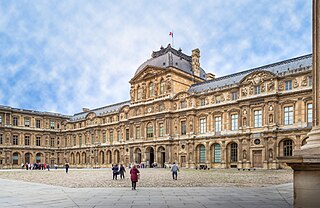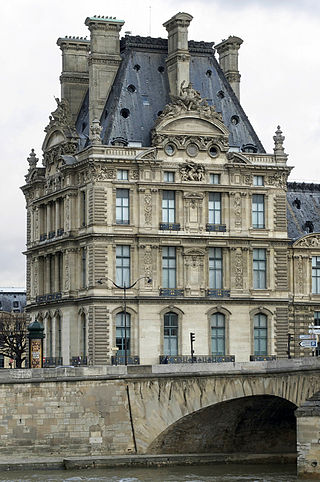
A national flag is a flag that represents and symbolizes a given nation. It is flown by the government of that nation, but can also be flown by its citizens. A national flag is typically designed with specific meanings for its colours and symbols, which may also be used separately from the flag as a symbol of the nation. The design of a national flag is sometimes altered after the occurrence of important historical events. The burning or destruction of a national flag is a greatly symbolic act.

The Union Jack, or Union flag, is the de facto national flag of the United Kingdom. The Union Flag was also used as the official flag of several British colonies and dominions before they adopted their own national flags. The flag continues to have official status in Canada, by parliamentary resolution, where it is known as the Royal Union flag.

The national flag of France is a tricolour featuring three vertical bands coloured blue, white, and red. It is known to English speakers as the Tricolour, although the flag of Ireland and others are also so known. The design was adopted after the French Revolution, where the revolutionaries were influenced by the horizontally striped red-white-blue flag of the Netherlands. While not the first tricolour, it became one of the most influential flags in history. The tricolour scheme was later adopted by many other nations in Europe and elsewhere, and, according to the Encyclopædia Britannica has historically stood "in symbolic opposition to the autocratic and clericalist royal standards of the past".

The national flag of Romania is a tricolour. The Constitution of Romania states that "The flag of Romania is tricolour; the colours are arranged vertically in the following order from the flagpole: blue, yellow, red". The flag has a width-length ratio of 2:3; the proportions, shades of colour as well as the flag protocol were established by law in 1994, and extended in 2001.

The flag of Newfoundland and Labrador was introduced in 1980 and was designed by Newfoundland artist Christopher Pratt. The flag design was approved by the House of Assembly of the province of Newfoundland, Canada, on May 28, 1980. It was flown for the first time on Discovery Day, June 24, 1980. The name of the province was changed to Newfoundland and Labrador by an amendment to the constitution of Canada in December 2001 at the request of the provincial legislature.

In British maritime law and custom, an ensign is the identifying flag flown to designate a British ship, either military or civilian. Such flags display the United Kingdom Union Flag in the canton, with either a red, white or blue field, dependent on whether the vessel is civilian, naval, or in a special category. These are known as the red, white, and blue ensigns respectively.

The national flag of Ivory Coast is a tricolour flag consisting of equal bands of orange, white, and green. The proportions of the flag are 2:3. It is the national emblem of the Republic of Ivory Coast as affirmed in Article 29 of the Constitution of Ivory Coast in 1960.

The national flag of Algeria consists of two equal vertical bars, green and white, charged in the center with a red star and crescent, a symbol of Islam as the nation's prominent faith. The flag was adopted on 3 July 1962. A similar version was used by the Algerian government in exile from 1958 to 1962. The Western blazon is per pale vert and argent; a crescent and star gules.

The Ottoman Empire used various flags and naval ensigns during its history. The crescent and star came into use in the second half of the 18th century. A buyruldu (decree) from 1793 required that the ships of the Ottoman Navy were to use a red flag with the star and crescent in white. In 1844, a version of this flag, with a five-pointed star, was officially adopted as the Ottoman national flag. The decision to adopt a national flag was part of the Tanzimat reforms which aimed to modernize the Ottoman state in line with the laws and norms of contemporary European states and institutions.

Nicolas Sanson was a French cartographer who served under two kings in matters of geography. He has been called the "father of French cartography."

An Islamic flag is the flag either representing an Islamic Caliphate or religious order, state, civil society, military force or other entity associated with Islam. Islamic flags have a distinct history due to the Islamic prescription on aniconism, making particular colours, inscriptions or symbols such as crescent-and-star popular choices. Since the time of the Islamic prophet Muhammad, flags with certain colours were associated with Islam according to the traditions. Since then, historical Caliphates, modern nation states, certain denominations as well as religious movements have adopted flags to symbolize their Islamic identity.

The Louvre Palace, often referred to simply as the Louvre, is an iconic French palace located on the Right Bank of the Seine in Paris, occupying a vast expanse of land between the Tuileries Gardens and the church of Saint-Germain l'Auxerrois. Originally a defensive castle, it has served numerous government-related functions in the past, including intermittently as a royal residence between the 14th and 18th centuries. It is now mostly used by the Louvre Museum, which first opened there in 1793.

La Réale was a galley of the French galley corps, and the flagship of the French galley fleet under Louis XIV. She was designed by Jean-Baptiste Chabert, and built in Marseille between 1692 and 1694.

The Pavillon de Flore, part of the Palais du Louvre in Paris, France, stands at the southwest end of the Louvre, near the Pont Royal. It was originally constructed in 1607–1610, during the reign of Henry IV, as the corner pavilion between the Tuileries Palace to the north and the Louvre's Grande Galerie to the east. The pavilion was entirely redesigned and rebuilt by Hector Lefuel in 1864–1868 in a highly decorated Napoleon III style. Arguably the most famous sculpture on the exterior of the Louvre, Jean-Baptiste Carpeaux's Triumph of Flora, was added below the central pediment of the south facade at this time. The Tuileries Palace was burned by the Paris Commune in 1871, and a north facade, similar to the south facade, was added to the pavilion by Lefuel in 1874–1879. Currently, the Pavillon de Flore is part of the Musée du Louvre.
Éditions Robert Laffont is a book publishing company in France founded in 1941 by Robert Laffont (1916–2010). Its publications are distributed in almost all francophone countries, but mainly in France, Canada and in Belgium.

Laurent d'Arvieux was a French traveller and diplomat born in Marseille.

The national flag of Ireland, frequently referred to in Ireland as 'the tricolour' and elsewhere as the Irish tricolour is a vertical tricolour of green, white and orange. The proportions of the flag are 1:2.
Thomas Gobert was a 17th-century French architect and engineer.



















